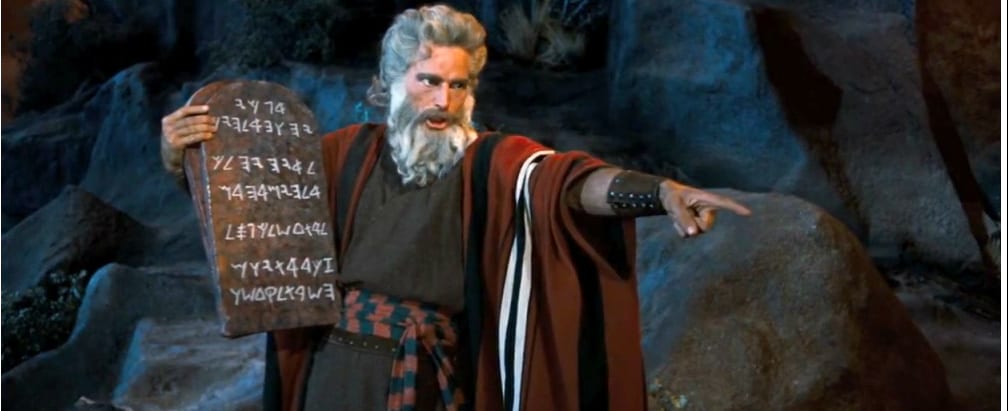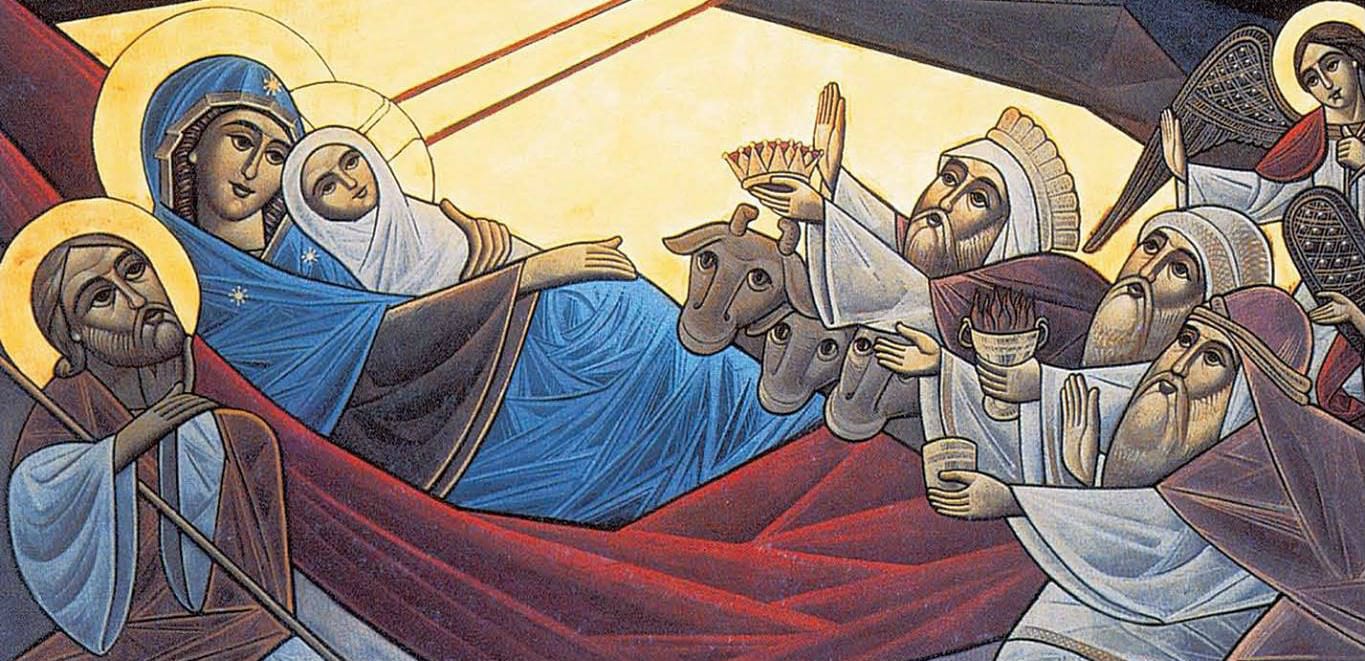Regina Caeli – Queen of Heaven, Rejoice!
The Regina Caeli, Latin for “Queen of Heaven,” is a hymn and prayer ...

True, Vatican II says that the Christian Life is supposed to be an intimate relationship, a dialogue between us and God.
But wait a minute. God is so different from us! His ways are not our ways. And if our puny minds have trouble understanding what He does, how much more do they stumble trying to understand who He is. Are not the agnostics right when they say that if God exists, He is so utterly beyond us that we cannot possibly know and say anything meaningful about him?
The Council, following all the great teachers of the Catholic Tradition, admits that God is absolute and incomprehensible mystery (DV 6). But in His loving mercy, he has stooped to our level so as to help us understand his loving plan for our lives. In what St. John Chrysostom calls his divine condescension, he has accommodated himself to our way of understanding. How do we communicate to one another? Through words and actions. So from the time of Abraham onwards, God has intervened in human history and communicated to us through words and deeds (DV2).
There are a couple of things to note about his communication with us, his revelation of himself and his plan for our salvation. First of all, he uses human words and deeds to speak to us, and these are told and passed on by human witnesses and are ultimately written down by human authors. Yet this very human process is guided and inspired throughout by His Holy Spirit, the divine Author of both the story and the actual books which recount that story (DV 7). The books that tell the story are collected into what we now call the Bible, which more traditionally was called the Sacred Scriptures (which simply mean Sacred Writings). They are a library written by various authors over a span of hundreds of years. Yet they are at the same time one unified book, telling one story of salvation, with one Divine Author, the Holy Spirit.
Throughout history, people have gone astray by failing to recognize the dual character of the Scriptures, which are the Word of God in the words of men (DV 13). To forget the human dimension of the Word leads to fundamentalism; to see only the human leads to secular humanism.
Another thing to note about God’s communication with us over the course of salvation history is that he was wise enough not to reveal too much about Himself too fast. One can compare our relationship to God to a human love relationship. When a couple begins courting, they don’t “tell all” on the first date. Rather, as they get to know each other better, they gradually reveal more and more about themselves. When their wedding day finally comes, they reveal themselves completely to each other, even physically. The total intimacy of marriage is the culmination of a progressively deepening relationship.
That’s the way God works with us too.
The story of revelation really starts with the pagan Abraham. God begins slowly to reveal himself to Abraham. He doesn’t spell out everything all at once. First of all, he must remove Abraham from his pagan environment so he draws him away from his home and leads him on a pilgrimage – a journey – that ultimately brings Abraham and his family to Egypt. But it’s not until about 600 years after Abraham’s first contact with God that the ten commandments are given. And even then he doesn’t tell them everything – like about eternal life, the Trinity, etc. That’s for later. First he has to get the idea across that they are to worship only one God, and that the primary way to please him is through a life of holiness and justice.
But eventually there came the time for the marriage, for God to reveal the most intimate secrets about Himself. That was when God sent his only son into the world. Jesus’s passover, his death and resurrection, is the ultimate moment when God revealed his entire self to us, as Eternal Love that is stronger than sin and death.
John, at the beginning of his gospel, calls Jesus “The Word”. So when we talk about the Word of God we are not primarily talking about the words of a book, but a about person, the Second Person of the Blessed Trinity, who was made flesh and gave his entire self to us.

The Scriptures, from Genesis to Revelation, point to Jesus Christ. The early Church Fathers said Jesus is the “condensed Word”, the abbreviated Word of God. The Scriptures are like Jesus’ body in a way analogous to the Eucharist, his sacramental body. Dei Verbum says the Church has always revered the Scriptures as it does the eucharistic body of Christ (DV 21). Though we don’t actually worship the bible, notice how we sometimes incense the gospel before it is read in Mass and how the priest frequently kisses the book. That is to show the veneration we have for Christ who really comes to us in his word. When the Scripture’s are read in faith in the liturgy, the Council teaches that the Lord Jesus is truly present in the power of his divine grace speaking directly to the congregation (Constitution on the Liturgy, par 7).
In giving us Jesus, God said everything He could possibly say. That’s why there is no further public revelation possible after Christ (DV 4), as the Mormons and Moslems mistakenly believe. If there were need for any further revelation after Jesus, then Jesus couldn’t have been perfectly the Word of God.
So how, then, do post-biblical prophecies or apparitions of the Blessed Mother fit in? First of all, the Church does not guarantee that any of these private revelations are authentic, even when received by canonized saints. Catholics are free to accept or reject them. Even when authentic, such messages do not provide new information that we need for the sake of our salvation.
So why would God send such messages? To provide a living, “now” word to his people helping them to know His will in the circumstances facing them in a particular time and place. That’s the role that prophets, visionaries, and apparitions have continued to play since Pentecost. I personally believe that Mary has visited the human race many times in the last twenty centuries and spoken important words of encouragement, guidance, and correction. If you examine Lourdes, Fatima, and other reliable apparitions, you will find that the messages delivered simply call us to take the age-old gospel more seriously and to live it with a sense of urgency – repentance, faith in Christ Jesus, hope for heaven, and love for God and all humanity. Such message always are delivered in a way that is perfectly suited to the historical context.
Though all was said once for all in Christ’s life, death, and resurrection, we’ve been busy for the last 2,000 years unpacking this incredible gift of God’s Word. And we have a lot more unpacking left to do. Our limitations as human beings mean that we don’t understand everything at once and we have to keep drawing more nourishment and insight out of what the Lord has spoken once and for all in his Son.
So guidance on how to interpret Scripture was an important part of Vatican II’s legacy. First of all, the council made clear that we are to respect and seek out the literal sense of Scripture, which is what the human author intended to teach us about God and our salvation through the words that he wrote (DV 11). That means that the original historical context of each book of the Bible and indeed each passage must be respected. It also means that we should make use of any scientific and historical tools that can be used to help us reconstruct this context thereby getting clearer insight into the meaning the text had for its human author and his original audience.
On the other hand, given that all of the books of the Bible also have the Holy Spirit as their author, we need also to interpret these books in the same Spirit in which they were written (DV 12). In other words, prayer, faith, and holiness provide an indispensable key to the unlocking of Scripture’s deepest meaning which sometimes exceeds the conscious intention of the human author. Since the Bible is a divinely authored library, each book should be interpreted in light of all the others – Old Testament in light of the New, New Testament in light of the Old (DV 16), with the Gospels (DV 18) and especially the death and resurrection of Christ as the dynamic center.
A few words in closing about the historical and scientific accuracy of the Bible. The Church has always guaranteed that the Scriptures teach faithfully and without error that truth which God wanted to communicate to us regarding our salvation (DV 12). However it is not at all clear that God or the biblical authors thought that an exact scientific explanation of how the world was created was necessary for our salvation. Divine inspiration does not exempt the biblical authors from the intellectual limitations of their respective ages when it comes to matters of science and secular history. Every book and every line of Scripture is “inerrant” insofar as it teaches us about God and our salvation, but is inerrant in no other way.
But there are some historical events that are critical to our salvation, notably the life, death, and resurrection of Jesus, as professed in the Nicene and Apostles Creed. From the days of the Early Church Fathers, it was clear that the four evangelists were not trying to provide us with an exact chronology of all Jesus’s sermons and miracles. There are discrepancies in matters of minor detail in the Gospels, like whether Jesus drove the moneychangers out of the temple at the beginning (Jn 2) or at the end (Lk 19) of his public ministry. But text-book history was not what the evangelists were writing. Their goal was to arrange the miracles and words of Jesus in such a way as to provide us with a picture of who Jesus was and what he did for our salvation. In this the four Gospels entirely agree and are utterly reliable, despite the slanderous fictions such as The Da Vinci Code which have come and gone ever since the Gnostic gospel of Thomas in the second century.
So the Catholic Church is thoroughly biblical. Indeed the Bible is a thoroughly Catholic book. In fact the next great contribution of the Second Vatican Council was to explain how the Bible can only be fully understood in its native context, namely, the Tradition of the Catholic Church. But we’ll save that for our next article, part three of our series on Vatican II and the Word of God.
This essay is part 1 of a four part series on Vatican II and the Word of God. It originally appeared in Good News, the magazine of the Catholic Charismatic Renewal of Great Britain. Inserted image used with Stéphane René’s permission. Please visit his website to view his beautiful icons.
To read Part 1 in Marcellino D’Ambrosio’s four part series on Vatican II and the Word of God, Faith as a Dialogue of Love, click here.
To read Part 3 in his four part series on Vatican II and the Word of God, Tradition and Magisterium, click here.
No Comments